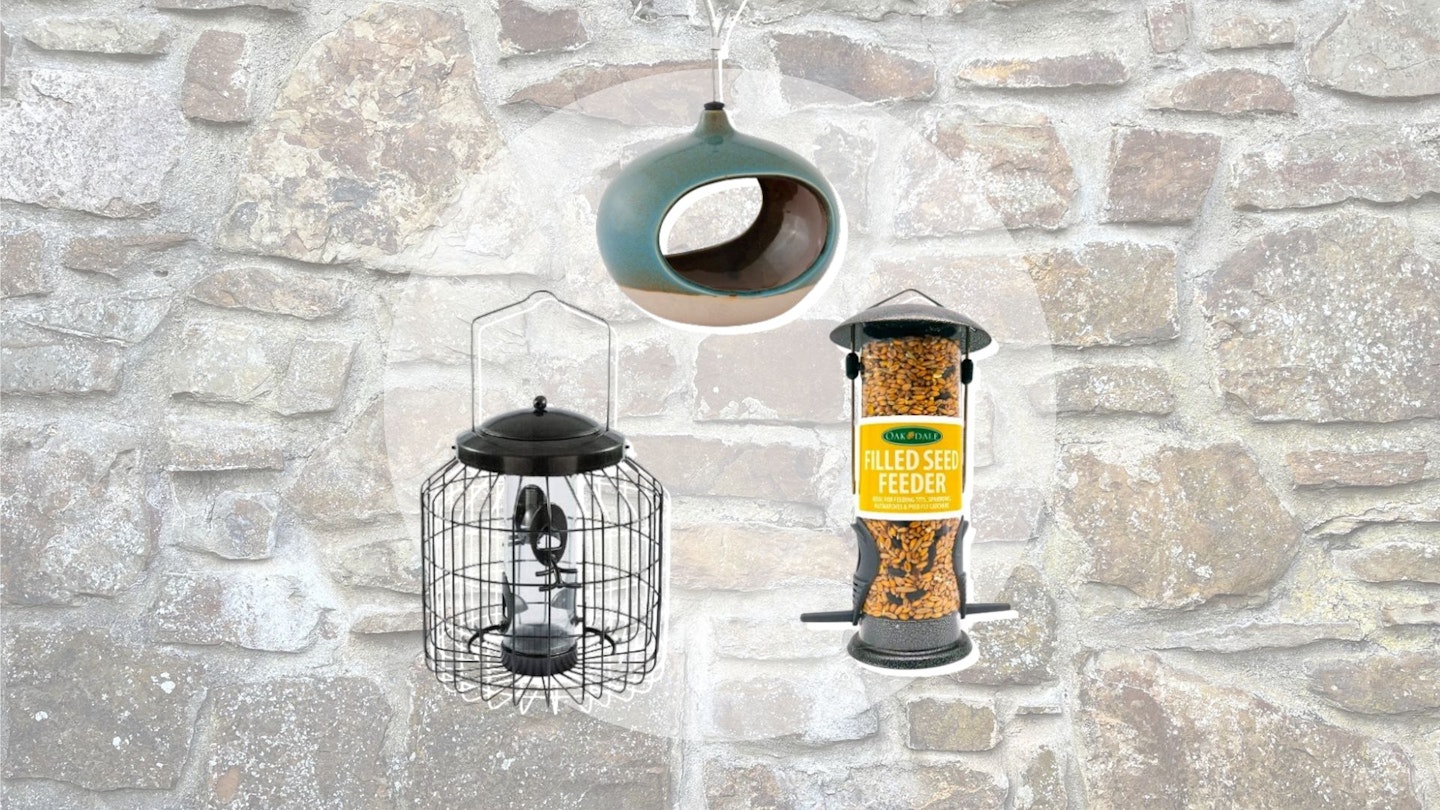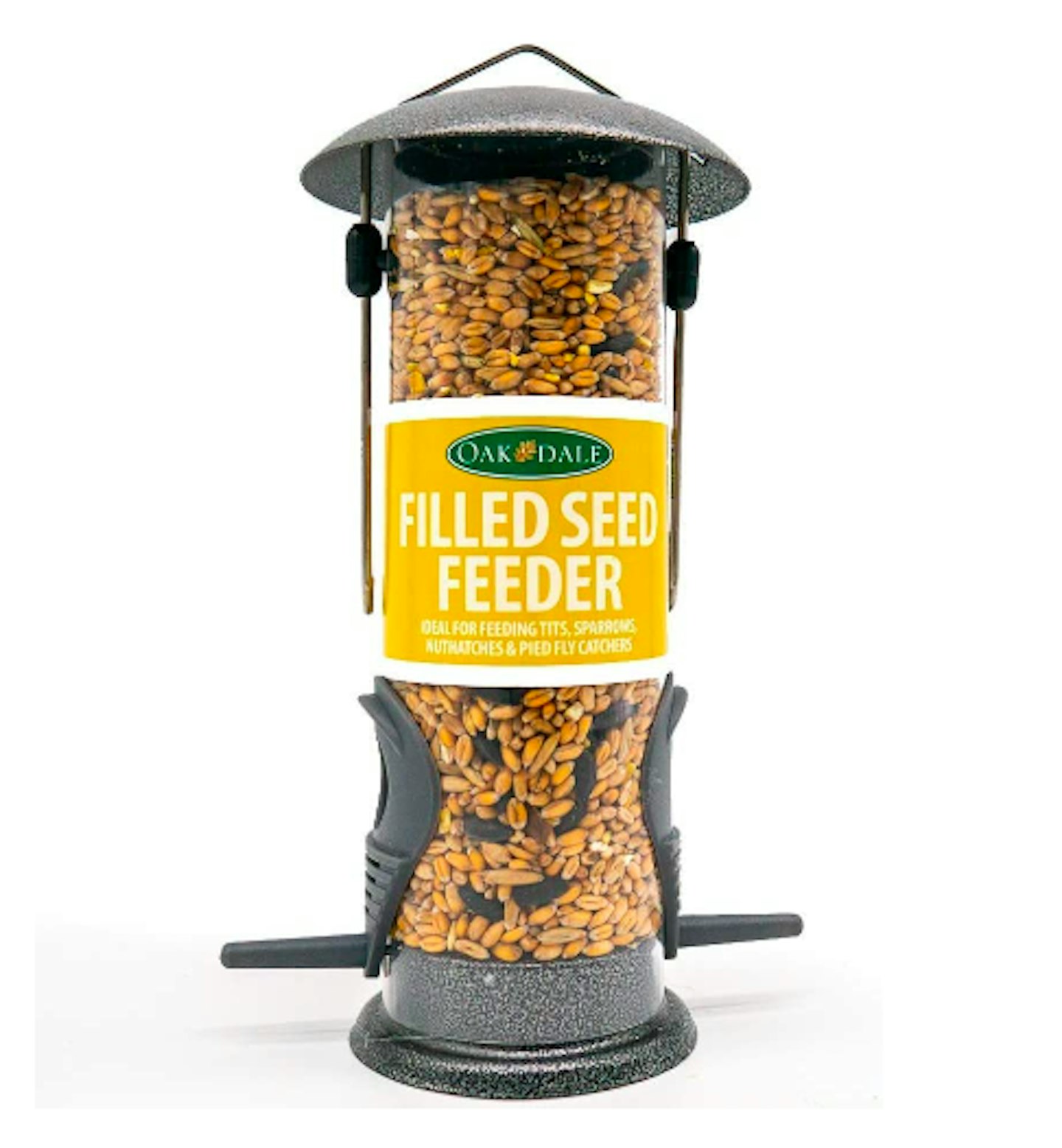Coming out of the winter months and into spring, we start to see more British garden birds make their way to our bird feeders looking for food - which is why it is vital to keep them fully stocked in all weathers. Putting a bird feeding station in your back or front garden allows space for these birds to come and perch when you want to enjoy British nature. From September, bird feeders should be placed in sheltered locations out of the most severe winds.
If you're upgrading your garden with some modern furniture or a cosy cocoon chair, you'll want something to watch while enjoying the outdoors and what better than a bird feeder to encourage wildlife into your outdoor haven? You can always think about having a bird bath in your garden too. If you really want to care for all creatures in your garden wildlife houses are a good idea for keeping useful and garden-friendly creepy crawlies safe, too.
Best bird feeders at a glance:
• Best all-in-one bird feeding station: Honeyfield's Wild Bird All-in-One Dining Station - View on Amazon UK
• Best window bird feeder: Kingfisher Window Bird Feeder - View on Amazon UK
• Best value bird feeder: Oakdale Wild Bird Feeder Pre-Filled with Premium Seeds - View on Amazon UK
• Best stylish bird feeder: Crocus Ceramic Diner Feeder - View on Crocus
Whether you want to enjoy birds flitting about your bird feeding station while you enjoy a cup of tea, or just see them come in and out of your garden, investing in a bird feeder can help to ensure your local wild birds keep coming back. Here's our selection of the best bird feeders we recommend, with every kind of garden or balcony in mind.
Best bird feeder stations for your garden
Best bird feeding station for easy assembly
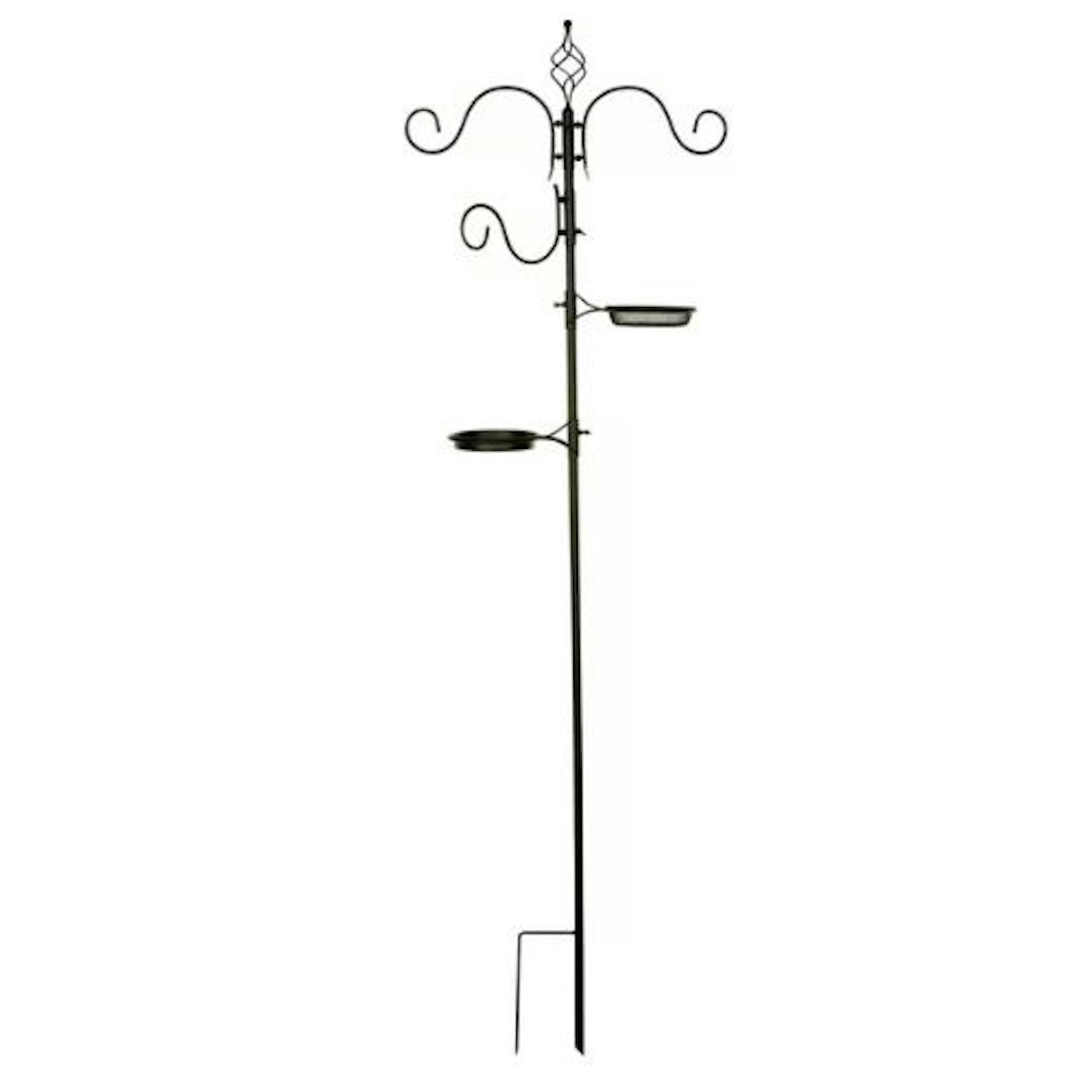 Argos
Argoswww.argos.co.uk
This is a great bird budget feeder offering different feeding heights that is extremely easy to assemble. We like that it's an all-in-one bird feeder so that you can offer food, water, and bird seeds all at once. With a spiked squirrel-resistant base, you'll have all the birds hanging out in no time.
This offers three arms to hang standalone bird feeders from, an easy-access food tray which is great for popping bird-safe kitchen scraps on, and a bird bath, or watering tray, depending on what your garden birds' hydration needs are.
Reviewers like the uncomplicated design which can be configured to suit your outdoor space, and the fact that it is so simple to assemble and stake securely in a special spot of your garden.
Pros
- Easy to assemble right out of the box
- Serves three purposes with hangers, a food tray, and a bird bath
- Doesn't take up much floor space
Cons
- Some reviews say it was thinner and shorter than expected
| Dimensions: | H187 x W57.5 x D17 cm |
| Weight: | 1.75kg |
Best bird feeding station with an all-in-one design
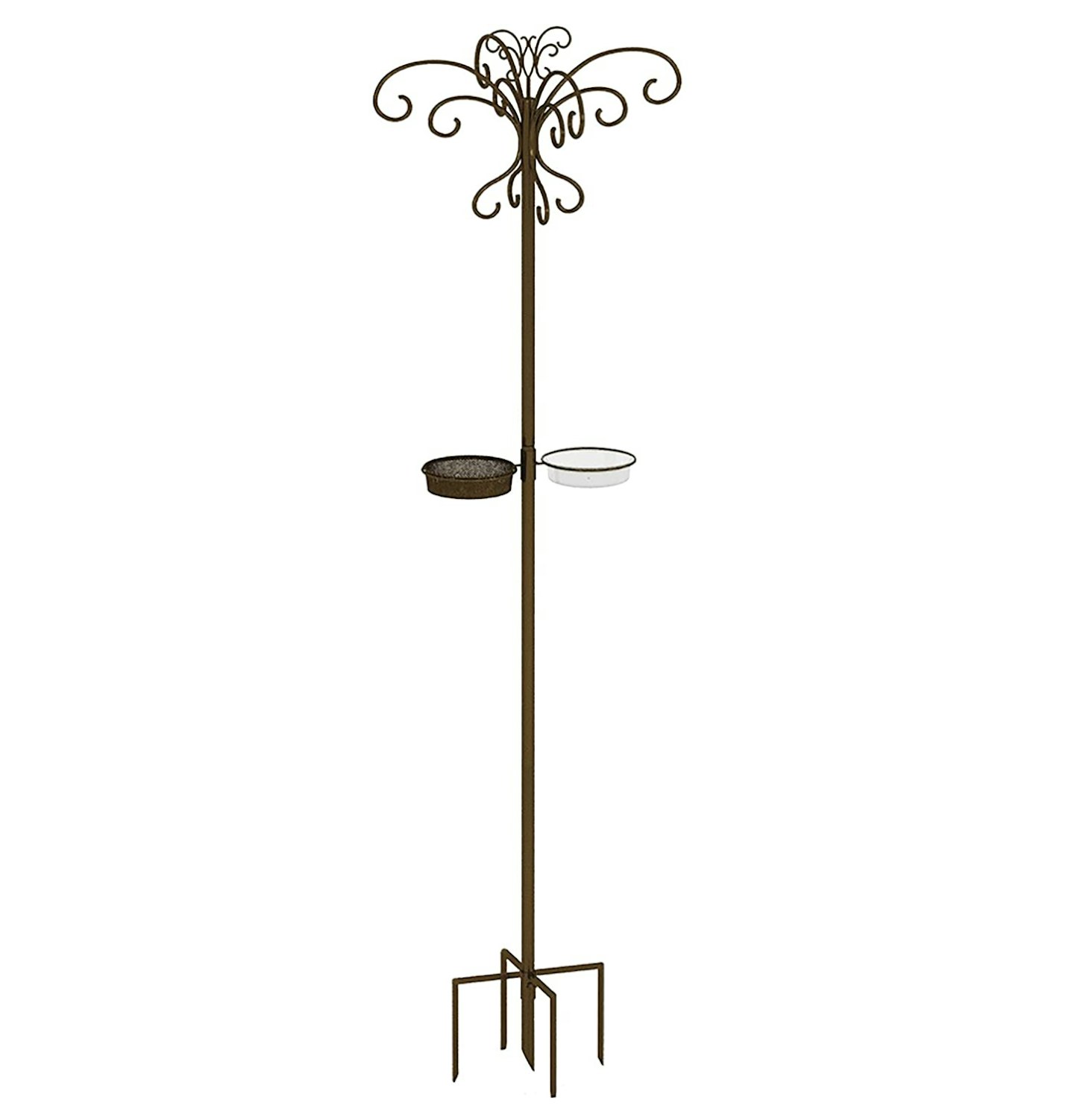 Honeyfield's/Amazon
Honeyfield's/AmazonThe birds will have lots of space on this all-in-one bird feeder with 12 hangers, giving lots of opportunities for bird-feeding action in your back garden. That many hangers means you can offer a variety of food to suit different bird breeds such as classic bird seed, peanuts, and nourishing fat balls.
While reviewers report assembly to be relatively easy, it's recommended to make sure to use the detachable four-fork base for extra stability. One reviewer did suggest this had a wobble when a particularly chunky pigeon paid a visit, so be sure to secure it.
One happy bird-lover describes this as the best bird station they have ever bought, praising it for being strong and sturdy.
Pros
- Twelve hanging points, so lots of room for different kinds of food
- Bronze finish makes it look striking
- Well-made with sturdy metal construction
Cons
- Some reviews say it shakes a lot in bad weather
| Dimensions: | 210H x 60W cm |
Best smaller bird feeder
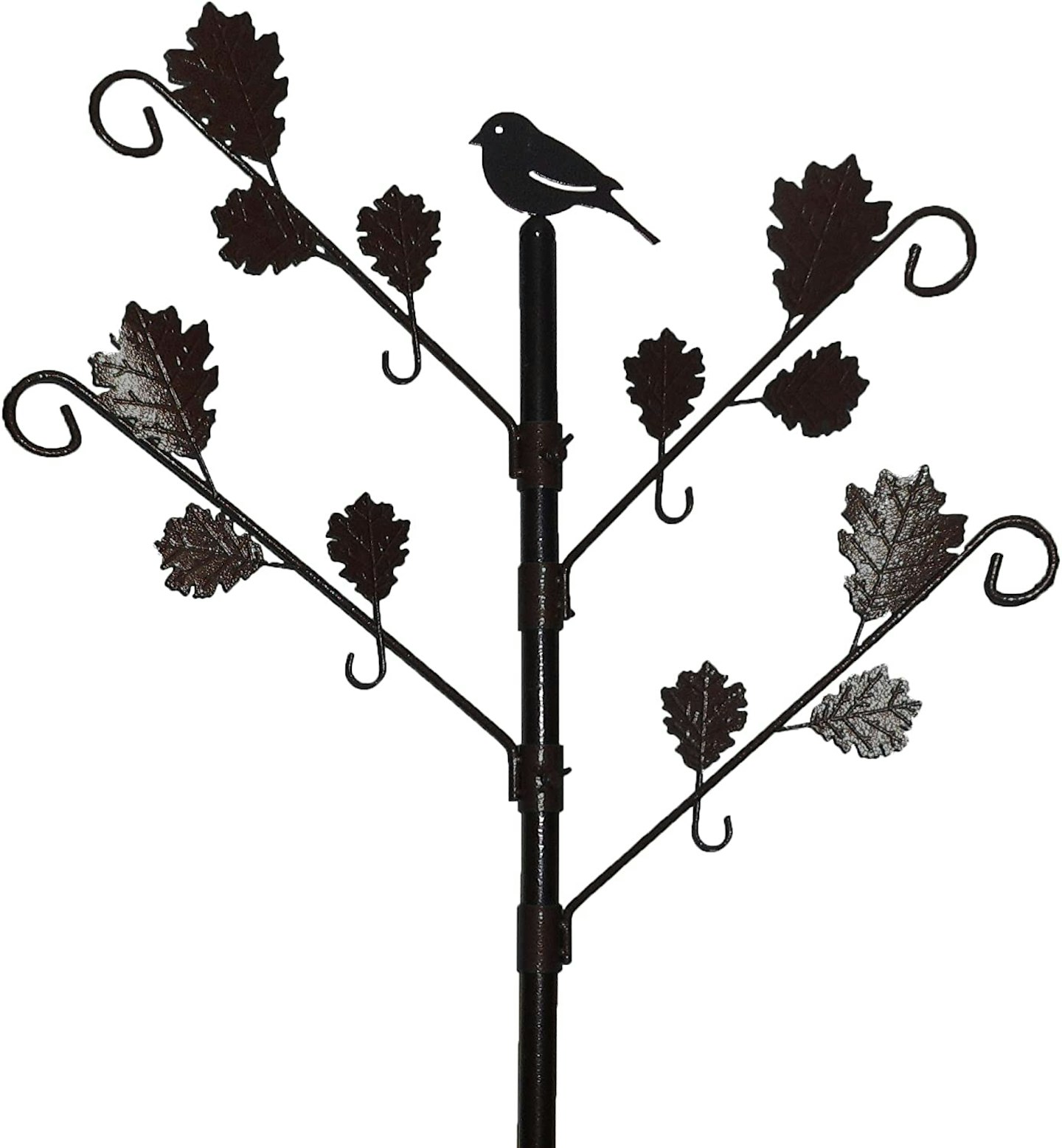 Green Jem/Amazon
Green Jem/AmazonThis Green Jem bird feeder is an attractive station to add to any modern garden. With the delightful cut-out leaves and bird silhouette detail, it gives a great amount of space for any bird to perch. You can modify each of the "branches" to your preferred position.
It's a smaller size so great if you'd like a bird feeder without taking up too much space. This does still offer eight different hanging spots, so there's plenty of scope to add a variety of different types of bird foods to keep your avian friends happy.
Many reviewers picked this bird feeder for aesthetical reasons as it's more decorative than standard options. The brown hammertone finish, described by some as almost like a bronzed effect, gets points for both looks and how weatherproof it is.
Pros
- Great for smaller outdoor spaces
- A decorative choice that has attractive detail
- Handsome brown hammertone finish
Cons
- Be careful of rust
| Dimensions: | 65.8H x 21.2W cm |
Best bird feeder with accessories
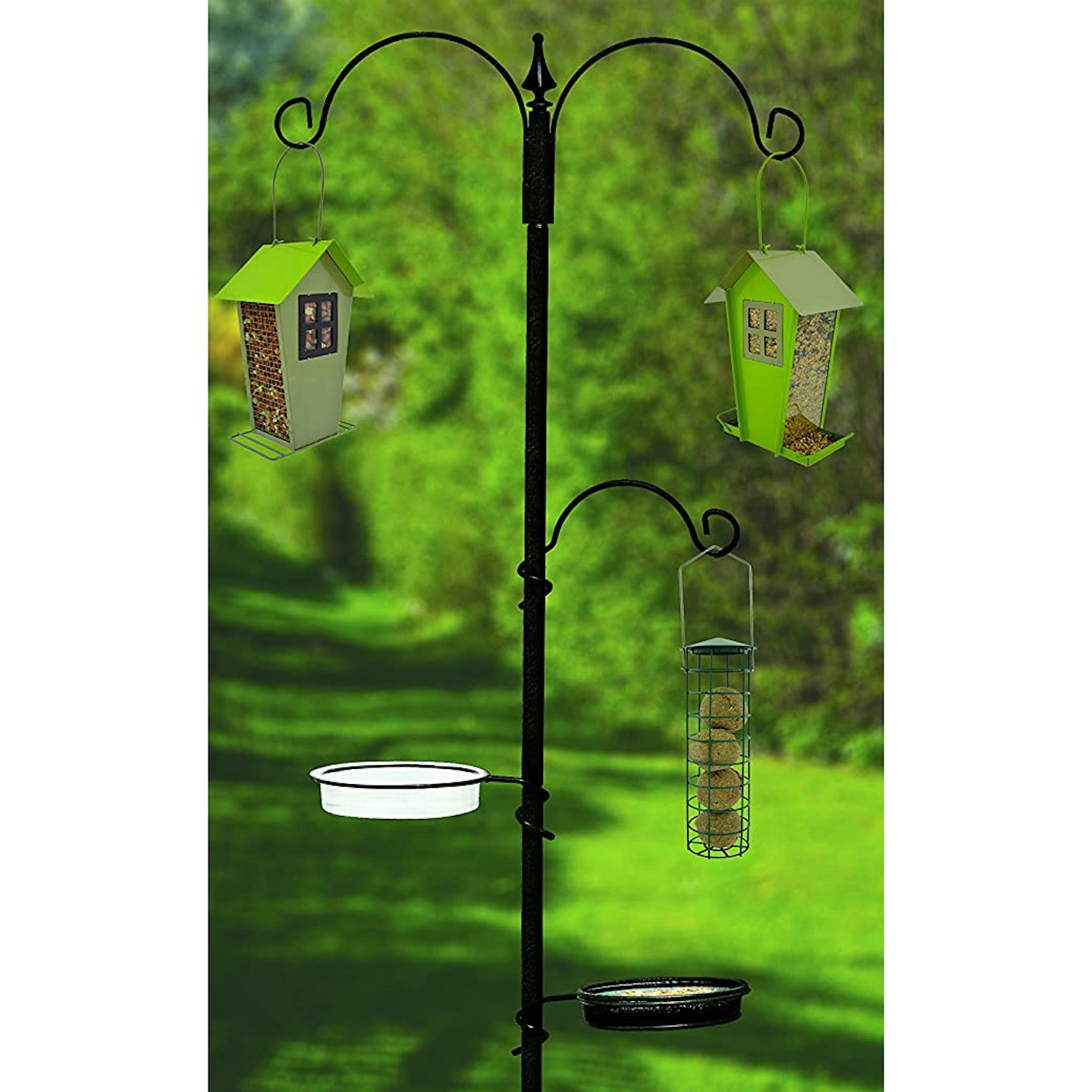 Supa/Amazon
Supa/AmazonThis Supa bird feeder is comprised of three pole sections that offer simple, tool-free assembly, something reviewers appreciate. There's a double bracket to hang two feeders from and one wrap-around bracket for heavier hangers.
The bundled plastic water dish and mesh tray attach to the pole sections with wrap-around brackets and are removable for easy filling and cleaning. With a 4.5-star Amazon rating, this option comes highly recommended by many happy bird-lovers.
Reviewers appreciate the sturdiness of this feeder, describing it as well-balanced for birds to perch on. One reviewer offers a handy tip to prevent squirrels from stealing your nuts - spray WD40 on the base of the pole.
Pros
- Option to hang different kinds of feeders
- Easy to set up with tool-free construction
- Decorative finial detail at the top of the feeder
Cons
- Some report the water tray gets damaged in transit
| Dimensions: | 188H x 21.2W cm |
Best simple bird feeding station
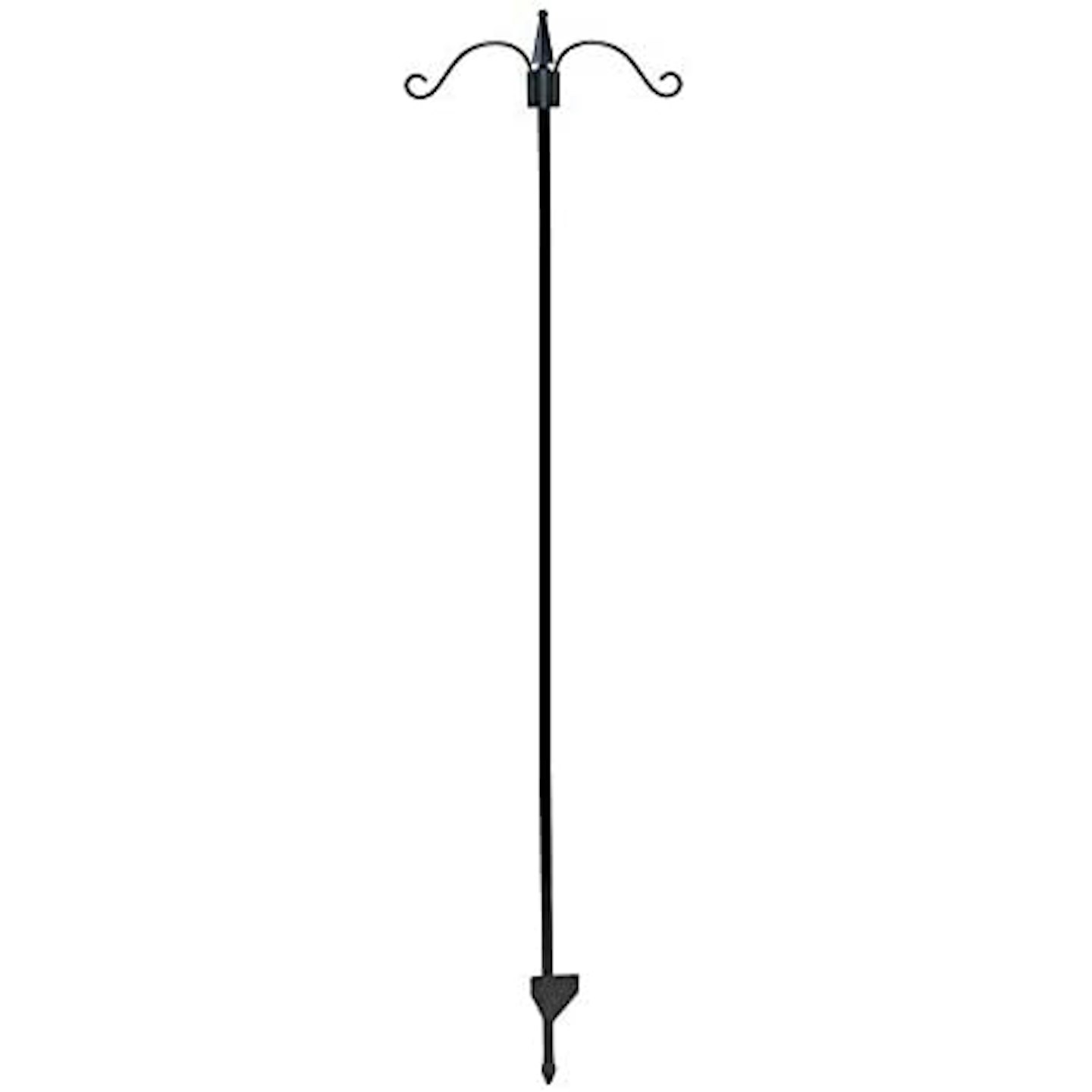 Honeyfield's/Amazon
Honeyfield's/AmazonNot looking for anything fancy? This Honeyfield's bird feeding pole is great if you just want a station that has a super-simple design and a price tag to match. With two hooks for your garden birds to perch on, and for you to hang feeders off, this is an easy bird feeder to manage.
Two well-stocked hanging feeders could attract wrens, great tits, blue tits, siskins, sparrows, finches, and if you're lucky, robins, although these birds are technically ground feeders, but could be tempted by the likes of nyger seeds or even mealworms.
This has a powder-coated, weather-resistant finish. There is a stability plate at the base of the pole to stop this toppling over in windy weather, although many reviewers advise adding additional stabilising materials, such as rocks or bricks, to make sure this stays upright in all weathers.
Pros
- Great if you're looking for a minimalistic look
- A simple two hook design for easy management
- Powder-coated, weather-resistant finish
Cons
- Shorter than other options at 188cm tall
| Dimensions: | 49H x 10W cm |
Best heavy-duty bird feeder
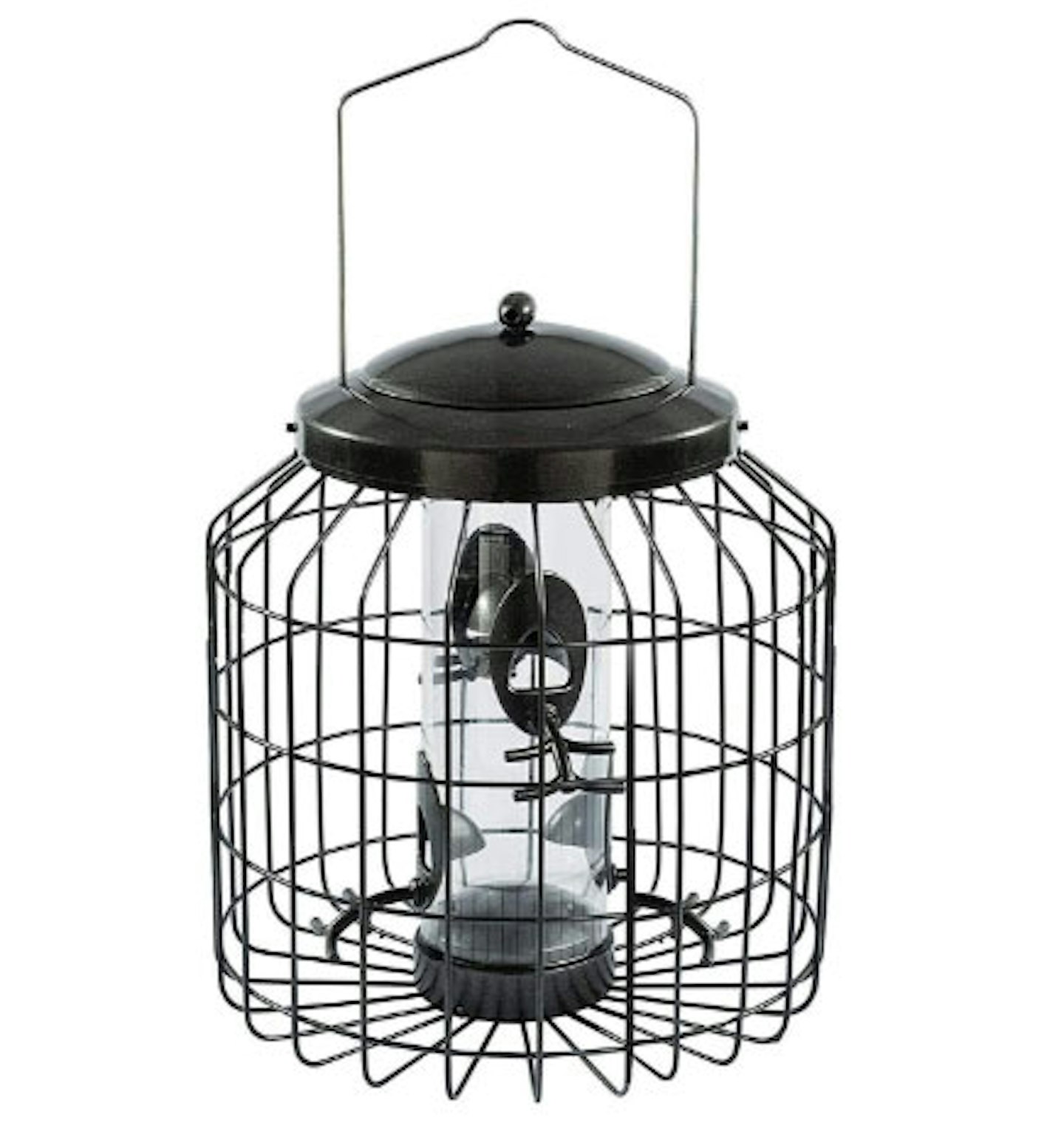 Gardman/Amazon
Gardman/AmazonSquirrels, cute though their antic are, can be a real pest for anyone who wants to feed the wild birds in their garden. This Gardman Heavy Duty Squirrel Proof Seed Bird Feeder, with its caged design, provides maximum resistance to squirrels and larger birds.
You can fill this up and it will last for a while, as it holds 500 grams of seed, 485 grams of peanut bites or 360 grams of sunflower seed. This caged feeder design makes it much easier for little birds to get some food and there are specially designed perches outside each feeding hole for the birds to rest on while they enjoy their snack.
One reviewer says they have experimented for years with supposedly squirrel-proof bird feeders but this is the only one they have found that actually works to stop squirrels stealing the food. Others rate this highly as being easy to fill and clean.
Pros
- This caged feeder makes it easier for smaller birds to get some food
- Don't have to worry about it getting blown away in the wind
- Perches inside the feeder for birds to rest on
Cons
- Doesn't look as pretty as some on the list
| Dimensions: | 24L x 24W x 29Hcm |
Best window bird feeder
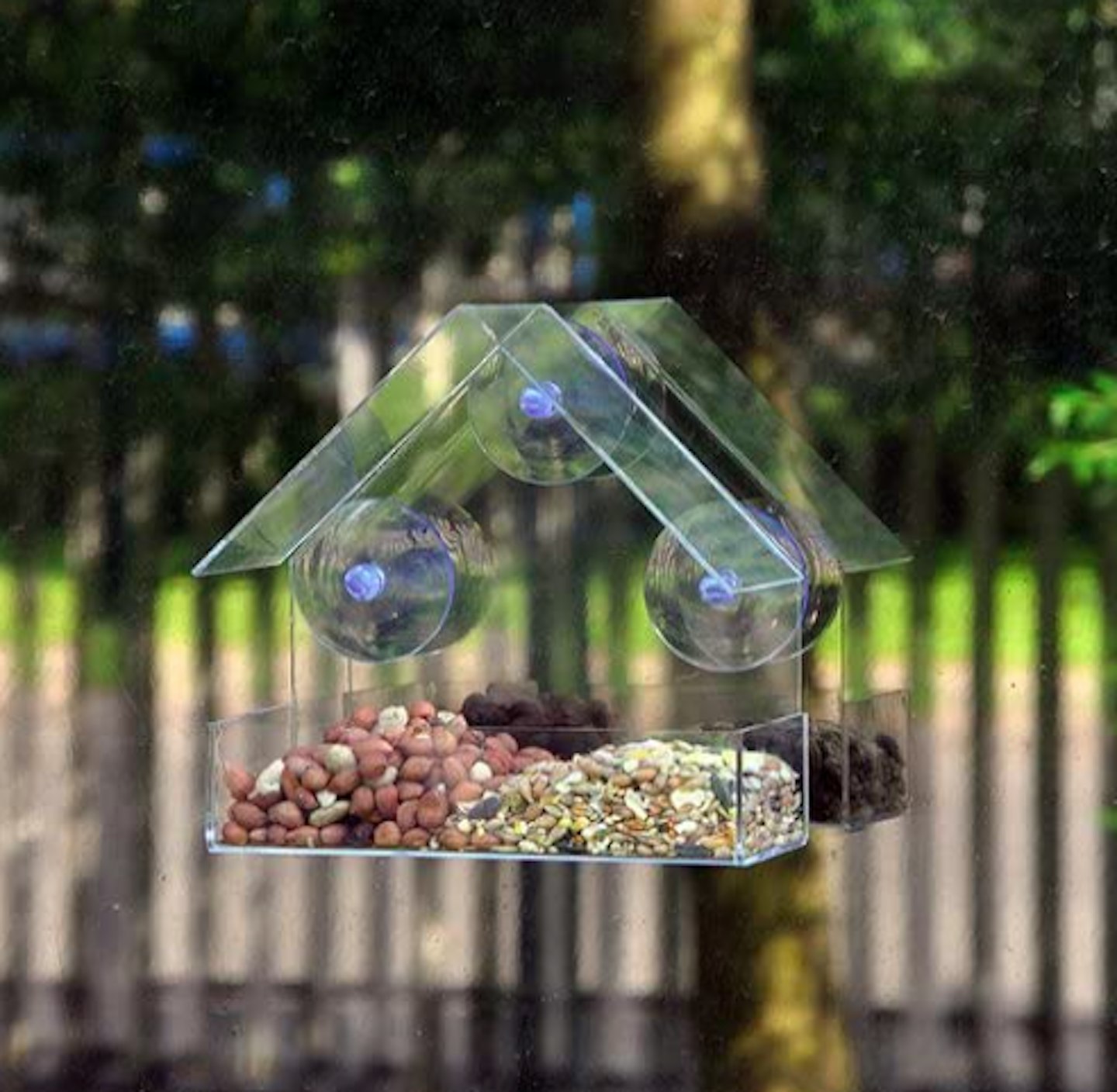 Kingfisher/Amazon
Kingfisher/AmazonNot everyone is lucky enough to have the outside space to stake or hang a bird feeder. You can still offer your neighbourhood bird buddies a bite to eat thanks to clever window bird feeders. The transparent design means you get a prime view of the birds landing and feeding.
This attaches to your window with three sturdy suction cups and has a small food tray for you to pour in your choice of bird food. There's a transparent roof to not only protect the food from the elements but for birds to perch on.
This Kingfisher option enjoys a 4.5-star Amazon rating with nearly 1,500 bird lovers giving it the thumbs up, stating it's great for attracting sparrows, tits, and even robins.
Pros
- Sturdy, takes the weight of the birds
- An attractive window feature for bird watching
- Transparent roof to shield the contents from the weather
Cons
- Be careful of marks on the window if you take it off
| Dimensions: | 17L x 7.7W x 16.7H cm |
Best stylish bird feeder
 Crocus
Crocus www.crocus.co.uk
Elegant, attractive, and stylish, this bird feeder from Crocus caught our eye. Easily the best-looking bird feeder in this collection, this is made from ceramics with a stylish two-tone colourway.
Simply hang the diner feeder from a suitable branch, feeder stand, or bracket - and wait for the birds to flock in. This feeder is suitable for a range of bird foods from seed mixes to suet pellets.
This comes in an attractive presentation box so we think it makes an excellent gift for discerning avian admirers. It seems at least one reviewer agrees with us, revealing they have ordered this three times for various relatives, all of whom have loved it.
Pros
- Elegant, attractive design
- Easy to hang from a branch or a stand
- Comes gift-boxed in attractive packaging
Cons
- Not frost-resistant
| Dimensions: | H12 x W14 x L12 cm |
How we chose the best bird feeders
All of these bird feeders have been hand-selected by our team of Modern Gardens shopping experts. We carefully considered size, suitability, and functionality in our selection of the best. Our team has spent hours investigating and researching the best bird feeders to make it easier for you to find the very best, and we'd never recommend a product we don't believe in.
Where possible, we also test and share the latest and best products you should know about. And with help from Modern Gardens Magazine, Garden News and Garden Answers, we share expert gardening knowledge to help you get the most from your product.
FAQs: Best bird feeders
Can I build my own bird-feeding station?
If you're an avid DIY-er, all you need is some wooden panels and a few screws. You may want to invest in some anti-fungal and anti-bacterial wooden gloss to ensure that the birds will be safe when they're eating.
Check out this video below for a full example of making your own bird feeder.
Can I feed birds on a budget?
Of course! Making your garden the best it can be doesn't have to be expensive, it can be a bargain. There are many ways of feeding birds than having to fork out on smaller supermarket packets frequently.
One way is to buy in bulk. If you have the space to store it then buying a large bag of birdseed or nuts is a great way to cut back on prices.
If you don't have space, you can also hand-make your own bird food. You can make fat balls with leftover fats from meats you may have already cooked. It's a great way to have a DIY session with kids or grandkids too!
Which bird feeder attracts the most birds?
According to the RSPB, there are different types of bird feeders to consider that will suit your garden and the type of wildlife you want to attract. So, we've got some information on that below.
Seed feeders: These are ideal for small birds to medium-sized birds like sparrows, robins, finches, woodpeckers and blackbirds and can be hung on a bird feeding station, tree, hook or anywhere suitable. They tend to come in a variety of shapes and sizes, so have fun picking out a seed feeder to fill with sunflower seeds and hearts, or other seed mixes.
Ground feeders: This is a bird feeding table that sits low to the ground and is ideal for birds like blackbirds, thrushes, wrens and robins. But these can also attract other animals looking for food like squirrels, pigeons, rats and cats so consider getting a protector cage to prevent them from getting access.
Nut feeders: These are perfect to attract birds like woodpeckers that can cling to the feeder and are often made from steel mesh. RSPB recommends, "The mesh size needs to be large enough to prevent beak damage and small enough to prevent large pieces of nut from being removed – about 6 mm is a good compromise."
Suet feeders: These feeders have wider holes so that birds can access the suet balls or suet cakes that fit inside. Suet feeders will likely attract members of the tit family and starlings.
Where should I hang a bird feeder?
It's easy to pick up a bird feeder from any common garden centre or home store in the UK. Usually, the problem is getting the bird feeder in the right place so that the birds actually feed on it and predators don't steal the food!
Firstly, you should always put your bird feeder or bird table near some green space - like a tree or bush. This helps to ensure the birds aren't exposed to the open and are safe from predators. This goes for noisy spaces too, which will scare birds off.
Remember stability. You want your bird feeder to be stable enough that it doesn't fall over and can take the weight of the birds. You can put metal spikes or secure hanging lines to ensure that it doesn't affect the feeder.
All birds are different, some like feeders higher up and others - like blackbirds - like to feed on the ground. Consider investing in a few feeders and placing them around your garden to test and see which works best. Remember you can leave out nuts and seeds on floors and flat spaces to see if birds start to pick them up.
Other animals can become a problem. Squirrels and foxes are pesky and will come back if they have access to constant food and scare away birds. To clarify, if you want to attract more birds, make sure to hang your feeders up higher. This is so foxes can't get them and away from any place, and squirrels can jump onto them. You can even get squirrel baffles to help protect your bird feeder, too.
How do I prepare my garden for nesting birds?
Spring is here - and we're shifting towards brighter days. Now, there will be warmer weather, more sunshine, blooming flowers and hopefully birdsong, too. At Modern Gardens, we're keen on getting everyone to create a haven for the wildlife native to the UK. Birda - a new birdwatching app - has some tips to attract birds into your backyard.
Food
First comes food. Feeding birds should "ideally be done to supplement any natural food sources, especially during periods of cold and before migration," says Birda. For example, plating natural vegetation in your garden - fruit, plant and seed will create a miniature ecosystem and help birds out. Plus, they're more likely to nest nearby food sources.
Not only that but "keeping your soil rich in nutrients and full of loam will encourage a host of worms and soil-dwelling creatures," meaning your birds will have even more food to gather. Additionally, leaving leaves raked under trees will keep the "soil warm and moist" which encourages a variety of leaf litter insects for birds to feed on.
With this, your garden may become a better nesting site. However, there are a few things to check before feeding the birds in your area. First, Birda recommends checking out local organisations for information on disease outbreaks. Just like us, bird species eat different things, "therefore will require different types of feeders," so Birda suggests leaning into a 'trial and error' approach when it comes to feeders, as feeding can change from bird to bird and the time of year.
Water
"Proximity to a quality water source will be a larger factor when considering your garden a site for nesting," says Birda. After all, birds need water to drink and clean themselves. When putting your bird baths out on the lawn, make sure the water is clean. Having a running water feature may prevent it from frosting during the colder months. Not only that but moving water is "natural-looking, reduced bacteria and is likely to attract more birds than still water."
Vegetation
Spaces that feel safe will attract birds, says Birda, and vegetation "is their primary means of finding this safety." If you have enough vegetation that will keep a shy sparrow or anxious finch sheltered, then you could be on track. After all, when vegetation is dense, birds can conceal themselves, "giving them protection from the elements and any other threats". Whether shrub, undergrowth or in a tree, vegetation can take many forms. Birda claims that "birds will thrive in and often prefer indigenous vegetation," so all of this will depend on where you live - and what you have around.
Safety from predators
As mentioned previously, safety is a bird's number one priority. As a result, birds will not nest where they feel unsafe. Though birds can fly away quickly from any predators, they're still at risk when they're wanting to feed, drink and nest. It's hard to keep your (and your neighbour's) cheeky little cat at bay, but making sure the birds have a fair chance to thrive depends on where you place bird boxes. According to Birda, birds will find a place to nest anywhere including in trees, in burrows and on the side of cliffs; even "man-made structures offer refuge in an urban environment."
Nesting materials
Lastly, there is the question of nesting materials - a garden with "adequately naturally occurring next construction material will be far more attractive to birds." For this Birda suggests not raking up "leaves and loose twigs, feathers, any loose moss or grass tufts" as this will encourage sweet-singing birds to take refuge in your garden. Birds will build with just about anything they can find though, so clean up any rubbish to avoid any harm to wildlife.
What to read next:
Beautiful bee inspired décor to brighten up your outdoor space
Subscribe to Modern Gardens magazine and get the most out of your outdoor space. Discover everything you need to know to make your outside space look fantastic, quickly and easily, with hundreds of simple ideas, designer tricks, affordable products and expert advice in every issue of Modern Gardens. View our latest subscription offers to save on shop prices.
Caitlin Casey is a Senior Beauty & Fashion Products Writer and a previous contributor for Modern Gardens Magazine.
